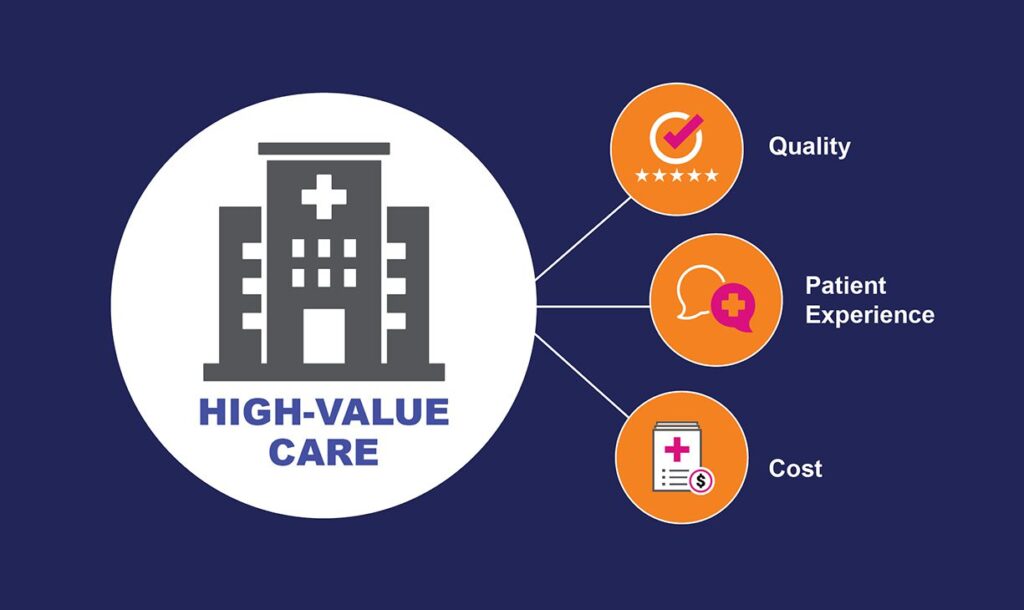
By focusing care management activities on areas with the potential for the greatest impact and making high-value decisions, care managers can optimize patient outcomes.
By Medecision
Most people would define value as “getting your money’s worth,” “a fair price for a product or service,” or something along those lines. Some might add that it also means not having to pay extra for unneeded or unwanted features or services. While the idea of value is subjective to a degree, it suggests satisfaction with a product or service that has delivered good quality at a reasonable cost.
What Is “Value” in Payer Care Management?
But what does it mean in the world of payer care management, which aims to manage the health of populations? (That goal is just one element of the widely pursued Triple Aim, which also seeks to improve the patient care experience while reducing per capita costs.)
For patients, value is likely to encompass such factors as easy access, convenience, personalization, engagement, quality and appropriateness of care, overall experience, and transparency of costs.
For payers, it’s likely to revolve around patient outcomes and performance metrics, as well as the all-important bottom line.
Fortunately, it is possible—and, in fact, preferable—for these varying ideals to coexist. But to make that a reality, care managers must learn to make high-value decisions that improve return on investment (ROI).
The High Cost of Unnecessary Medical Care
Why does healthcare cost so much? One major contributor to the problem is unnecessary procedures and tests. These don’t benefit anyone. Patients certainly don’t welcome them, and while they may appear on the surface to boost a provider’s revenue, they erode consumers’ trust in the healthcare system. They also devour time, energy, technology, equipment and other limited resources that would be better invested elsewhere.
Reporter Marshall Allen, in a 2018 article for ProPublica headlined “Unnecessary Medical Care Is More Common Than You Think,” provides examples of overused or unnecessary services:
- Annual cervical cancer testing (tests are recommended every three to five years for most women)
- Unnecessary lab work before elective procedures
- Annual electrocardiograms and other heart tests
These and other unnecessary tests and procedures add an estimated $765 billion a year in healthcare costs, according to the National Academy of Medicine, amounting to one-quarter of the nation’s annual healthcare spending.
High-Value Decisions in Value-Based Care
The traditional fee-for-service payment structure rewards providers for volume and quantity, while giving short shrift to patient outcomes, quality and efficiency of care. In recent years, however, there has been an increasing shift toward value-based care (VBC), which prioritizes value. This shift requires health plans to share and manage risk across all business lines and provider networks while optimizing member health and well-being.
The ongoing COVID-19 pandemic has highlighted both the shortcomings of the fee-for-service model—such as the difficulty of being reimbursed for services—and the opportunities to provide better, more efficient care using VBC models. During the pandemic, payers have struggled with an influx of high-cost COVID-19 patients who are not of Medicare age; declining volume; and rising Medicaid business, which is the highest-cost business to provide because of social determinants of health (SDoH) issues requiring increased care management services.
This crisis has demonstrated the need for three hallmarks of the VBC approach:
- A holistic model of care that emphasizes population health and addresses SDoH issues such as housing, transportation, access to healthy food, employment and education level
- Increased virtual care delivery, which has proved to be highly cost-effective
- More community-based care models that address gaps in resources
Zeroing In on Value
In a recent blog post, we suggested a possible reimagining of care management, citing a recent McKinsey & Company article titled “The Untapped Potential of Payer Care Management.” That article proposes “a more expansive definition … that involves any payer-driven efforts to engage with targeted members and their care ecosystems to encourage and enable high-value decisions.”
McKinsey breaks down payer sources of value into two categories: potential medical cost opportunities and potential revenue opportunities. Medical cost sources of value include care management programs that focus on prevention, as well as factors such as site of care; unit price; and appropriate diagnosis, treatment and management.
Revenue sources of value include clinically appropriate and accurate coding; closing care gaps; improving performance on measurements such as Consumer Assessment of Healthcare Providers and Systems (CAHPS) and Medicare’s Star ratings; and member attraction, retention and increased coverage.
In addition to helping patients avoid unnecessary procedures and tests, McKinsey recommendations include driving patients to in-network providers and encouraging them to make clinically appropriate choices about where they seek care.
By focusing care management activities on areas with the potential for the greatest impact and making high-value decisions, care managers can optimize patient outcomes and performance metrics, improving consumer experience, engagement and loyalty. They can also focus scarce resources on managing those members who need the most support while avoiding unnecessary emergency department and hospital visits. And we all can see the value in that.



About The Author: Medecision
Fully delivering on the promise of data — and making the business of healthcare simpler and more successful — Medecision offers a whole new world of possibilities. The company's flagship offering, Aerial™, stands as the market's most extensible clinical data platform. It offers complete contextual awareness of members and automates next best actions — simple campaigns, complex care management, utilization approvals, and more — for optimal health outcomes.
Aerial is not only quick to deploy, it is easy to manage. The platform's effectiveness in reducing both medical and administrative costs, coupled with its role in improving the member and patient experience, has made it the preferred choice for health plans and care delivery organizations. Presently, Aerial is instrumental in catering to over 10% of the U.S. population, marking a significant milestone in advancing healthcare efficiency and effectiveness.
More posts by Medecision